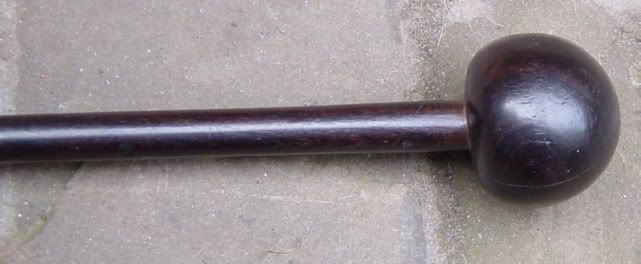
 |
|
|
|
|
#1 |
|
Member
Join Date: Dec 2004
Location: What is still UK
Posts: 5,855
|
Here are some pics of a one of my "black patina"? Zulu things, the easy one to take pics of. I know it is difficult to show this through a pic on a PC but I think there is quite a discernable difference.
   
|
|
|

|
|
|
#2 |
|
Member
Join Date: Jun 2006
Location: On the banks of Cut Bank Creek, Montana
Posts: 189
|
I forgot to upload the pictures this morning with my example of Zulu patination.
This is a 1960's maidens Milk pail. The first taken with a flash to show surface texture. Notice the wood grain  The second availbable light to show color textures. Notice it is not uniform  There is one other characteristic that you can't see, this milk pail smells of wood smoke. All the original wood that I have seen so far on Zulu weapons and tools is raw wood, light colored. Any dark wood has been "enhanced" for the antique market. None of the enhanced objects smell of smoke. It's a shame too as some of the objects would be very nice if left alone. Another thing that strikes me about the axe, the rivet. I haven't seen any Zulu metal work yet, with a rivet. Doesn't mean it doesn't exist, just means I haven't seen it. Ebay feed back. Positive feed back is almost meaningless. It means the goods were shipped out fast and the receiver liked them. It doesn't serve to verify authenticity. Hidden feedback is meaningful, it means buyer beware. |
|
|

|
|
|
#3 |
|
Member
Join Date: Dec 2004
Posts: 1,712
|
But such rivets are common on cheap Victorian herb choppers DD.
Here another one higher quality one posted by Flavio still clearly marked... http://www.vikingsword.com/vb/showth...highlight=herb So either the Zulus used herb choppers as axes? or at some time thiers been at least one cottage industry turning these out? Or several dodgy dealers into woodwork? A cabinet maker can duplicate age very easy & match any orignal piece of timber as far as the eye can see. Spiral |
|
|

|
|
|
#4 |
|
Member
Join Date: Jan 2006
Location: Kent
Posts: 2,658
|
Hi Bill, I am no expert.....when you first posted this thread...I viewed the pictures and my 'gut feeling' is that both items are relatively new. I have returned to them several times and the 'feeling' has not changed.
I agree that the stick looks too perfect, consistant colour, no wear marks on the raised parts of the chequered pattern, no dinks to the knob and the lathe (?) working marks on the smoother sections. The axe, also raises concerns, of which Spiral and others have pointed out. Cracks in wood are not always the result of age, wood that is not properly seasoned will develop such cracks. If the axe was forged in Africa, it makes no sense in using a rivet. Firstly, it is unnecesary complication, a hole would have to formed in the blade, the supporting shaft would require two coresponding holes, and a rivet forged. And secondly, the resulting 'ensemble' would be weaker compared to a similar axe head with a tang forged in 'one piece'.(which would be much easier and quicker to manufacture.) So to me the rivet suggests 'mass production'.... my 10 cents worth.... |
|
|

|
|
|
#5 |
|
Member
Join Date: Dec 2004
Location: Kernersville, NC, USA
Posts: 793
|
Bill, I have a walking stick very very similar to that. It was bought 2 years ago in a shop in Myrtle Beach, SC that sells African crafts. It's a very nice stick, but new. Don't know about the ax, but what kind of collector would have a piece with red rust? Send them back. You'll never be happy with them.
Steve |
|
|

|
|
|
#6 |
|
Member
Join Date: Dec 2004
Posts: 1,712
|
I havent handled much African stuff so cant comment from expierience of them.
But Ive handled a lot off wood & steel of many ages. I wouldnt be happy to keep them in my collection. Probably explains how come the sellor has such an infinate supply.  Spiral |
|
|

|
 |
|
|